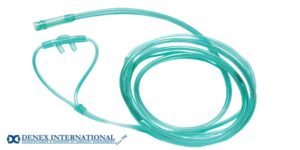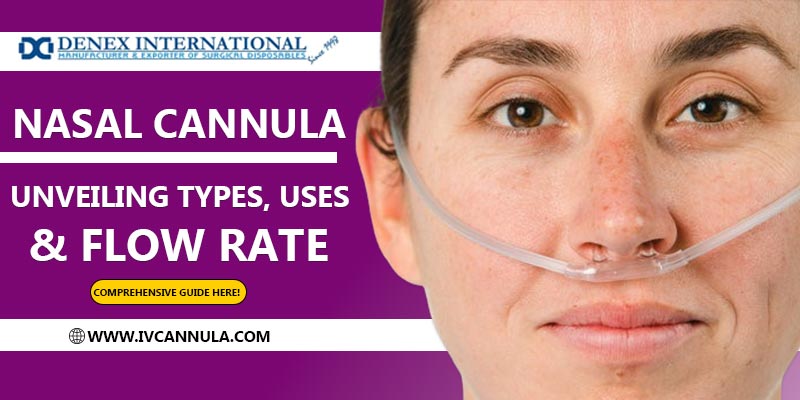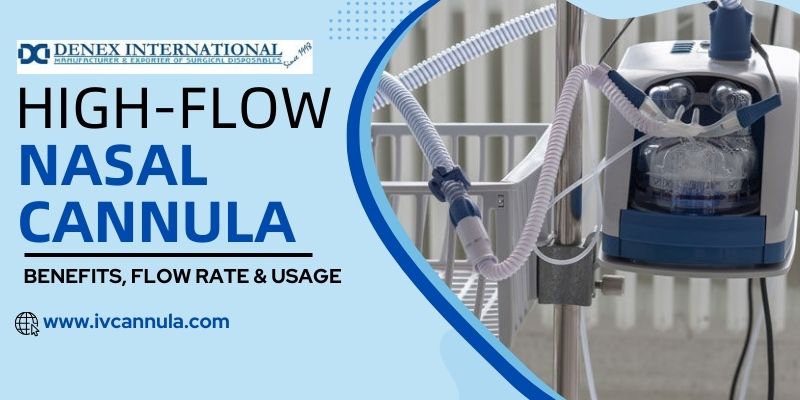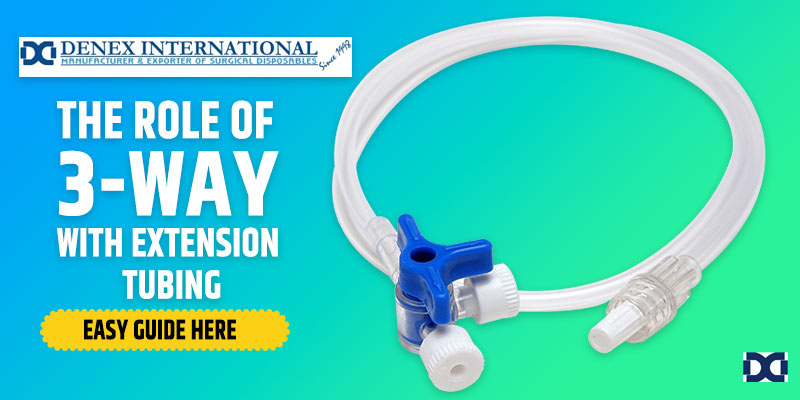Denex International, a leading Cannula Manufacturer, takes you on a comprehensive journey through the world of nasal cannulas. This guide delves into the diverse types of nasal cannulas, their varied uses, and the critical aspect of determining optimal flow rates for effective oxygen therapy.
Nasal Cannula Types Uses and Flow Rate
A nasal cannula is a medical device for delivering supplemental oxygen to individuals needing respiratory support. Consisting of lightweight tubing and two prongs that fit into the nostrils, the nasal cannula allows a continuous flow of oxygen from an oxygen source to the patient. This non-invasive method is commonly employed in various healthcare settings, including hospitals, clinics, and home care, providing a comfortable and effective means of oxygen delivery.

Types of Nasal Cannula:
Nasal cannulas come in various types, each designed to meet specific medical requirements. The standard nasal cannula comprises 2 prongs that fit into the patient’s nostrils, delivering supplemental oxygen.
Soft-Flow Nasal Cannula: Soft-flow cannulas enhance patient comfort, while curved-prong cannulas are tailored for a secure fit.
High FLow Nasal Cannula: High-flow nasal cannulas, designed to provide a more significant volume of oxygen, offer a versatile solution for varying patient needs.
Uses of Nasal Cannulas:
Nasal cannulas are extensively utilized in healthcare settings to deliver supplemental oxygen to patients with respiratory conditions. They are particularly beneficial for individuals requiring long-term oxygen therapy or those recuperating from surgery. Nasal cannulas find applications in various medical scenarios, including hospitals, clinics, and home healthcare settings, providing a non-invasive and comfortable method of oxygen delivery.
Optimal Nasal Cannula Flow Rates:
Determining the correct flow rate is crucial for the efficacy of nasal cannula oxygen therapy. For adults, initial flow rates typically range between 2 and 6 litres per minute (LPM), while for pediatric patients, it may vary from 0.25 to 2 LPM. Individual patient factors, such as age, respiratory condition, and overall health, influence decision-making. Regular monitoring and adjustment of flow rate ensure that patients receive the right amount of oxygen tailored to their needs.
Benefits of using a Nasal Cannula
Using a nasal cannula for oxygen therapy has various benefits, contributing to its widespread adoption in healthcare.
Non-Invasive Comfort:
Nasal cannulas offer a non-invasive and comfortable method of delivering supplemental oxygen. Patients can breathe easily while maintaining their freedom of movement, promoting comfort throughout the therapy.
Adjustable Oxygen Flow:
One significant advantage is the ability to customize the oxygen flow rate. Healthcare providers can tailor the treatment to meet individual patient needs, ensuring that the prescribed amount of oxygen is delivered effectively.
Cost-Effective Solution:
Nasal cannulas are a cost-effective option for delivering oxygen therapy compared to more complex and invasive methods. This makes them a practical choice for long-term treatment, minimizing financial burdens for healthcare facilities and patients.
Minimal Risks:
The use of nasal cannulas poses minimal risks to patients. The non-invasive nature reduces the likelihood of complications, making it a safe and reliable choice for individuals requiring continuous oxygen support.
Ease of Application and Removal:
Nasal cannulas are easy to apply and remove, contributing to their user-friendly nature. This simplicity enhances patient compliance, as the process is not burdensome, allowing for seamless integration into daily routines.
Versatility Across Settings:
Nasal cannulas are versatile and adaptable in a hospital, clinic, or home care environment. Their applicability across different healthcare settings makes them a go-to choice for various patient needs.
Promoting Patient Independence:
Nasal cannulas empower patients by allowing them to maintain independence during oxygen therapy. Patients can go about their daily activities without the constraints associated with more intrusive delivery methods.
How Much oxygen does a nasal cannula provide?
The amount of oxygen a nasal cannula delivers depends on the prescribed flow rate, measured in litres per minute (LPM). Nasal cannulas are designed to provide low to moderate oxygen concentrations, making them suitable for patients with mild to reasonable respiratory needs.
Typically, the flow rates for nasal cannulas range from 1 to 6 LPM, with expected starting rates for adults set between 2 to 4 LPM. At these rates, a nasal cannula can provide an approximate oxygen concentration of 24% to 40%, depending on the individual’s breathing pattern.
It’s important to note that higher flow rates may lead to increased discomfort, dryness, or irritation of the nasal passages. The effectiveness of oxygen therapy also relies on the patient’s ability to breathe primarily through their nose, as mouth breathing or nasal obstructions may diminish the overall efficacy.
Alternative devices, such as masks or high-flow nasal cannulas, may be considered for individuals with higher oxygen requirements. Healthcare professionals carefully assess the patient’s condition and oxygen needs to determine the appropriate flow rate and delivery method, ensuring that the prescribed therapy meets the individual’s respiratory requirements. As always, the specific details regarding oxygen therapy, including flow rates, should be discussed with healthcare providers to ensure personalized and optimal care.
Disadvantages of using a nasal cannula
While nasal cannulas are widely used for their convenience and effectiveness in oxygen therapy, there are some disadvantages associated with their use:
Limited Oxygen Delivery Capacity:
Nasal cannulas may have limitations in delivering higher oxygen concentrations compared to other devices, such as masks. In situations requiring a significant increase in oxygen levels, alternative delivery methods might be more suitable.
Potential for Nasal Dryness and Irritation:
Extended use of nasal cannulas, especially at higher flow rates, can lead to nasal dryness and irritation. This discomfort may result in reduced patient compliance, as individuals may find the therapy less tolerable.
Incompatibility with Mouth Breathers:
Nasal cannulas are designed for individuals who primarily breathe through their noses. Mouth breathers or those with nasal obstructions may not benefit from oxygen therapy with a nasal cannula, necessitating alternative devices.
Risk of Dislodgement:
The positioning of the nasal prongs makes them susceptible to dislodgement, particularly in active or restless patients. This can result in interruptions to oxygen delivery and may require frequent adjustments to ensure proper placement.
Dependency on Patient Cooperation:
Effective use of nasal cannulas relies on the patient’s cooperation and understanding of the therapy. Some individuals may struggle with keeping the cannula in place or may remove it unintentionally, impacting the overall effectiveness of the treatment.
Not Suitable for High-Flow Requirements:
In cases where patients require very high oxygen flow rates, nasal cannulas may not be the most suitable option. High-flow nasal cannulas exist, but alternative devices like non-rebreather masks or ventilators may be more appropriate for high oxygen requirements.
Appearance-Related Concerns:
Some patients may experience self-consciousness or discomfort about the appearance of the nasal cannula, particularly in social or public settings. This could impact their willingness to comply with prescribed therapy.
It’s important to note that while nasal cannulas have disadvantages, their benefits often outweigh these drawbacks for many patients. Healthcare professionals carefully consider individual patient needs and conditions to determine the most appropriate oxygen delivery method.
Considerations for Effective Oxygen Therapy:
In addition to selecting the appropriate type of nasal cannula and determining optimal flow rates, healthcare providers must consider patient comfort and compliance. Monitoring signs of discomfort, dryness, or irritation in the nasal passages allows for necessary adjustments. Clear communication with patients fosters a collaborative approach, enhancing the overall effectiveness of oxygen therapy while ensuring their well-being.
Conclusion:
In conclusion, mastering the intricacies of nasal cannulas involves understanding their types, uses, and optimal flow rates. Denex International, as a trusted Cannula Manufacturer, emphasizes the importance of precision and individualization in oxygen therapy. By exploring the diverse options available, tailoring flow rates to patient needs, and prioritizing comfort and compliance, healthcare providers can deliver effective and compassionate care through the versatile nasal cannula.







